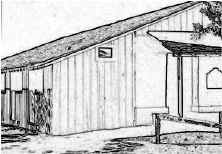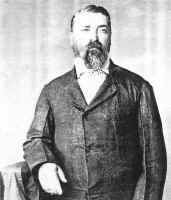
Louis Wolf and his Store
by Dick Diamond
 The
oldest standing building in Temecula Valley is the Louis Wolf
store. It is located on a piece of property about 400 yards southeast of the
corner of Highway 79 South and Redhawk Parkway. Although the oldest structure in
the area is an adobe on Nature Conservancy lands on the Santa Rosa Plateau (west
end of Clinton Keith Road)--the Wolf Store is the oldest in the valley proper.
The
oldest standing building in Temecula Valley is the Louis Wolf
store. It is located on a piece of property about 400 yards southeast of the
corner of Highway 79 South and Redhawk Parkway. Although the oldest structure in
the area is an adobe on Nature Conservancy lands on the Santa Rosa Plateau (west
end of Clinton Keith Road)--the Wolf Store is the oldest in the valley proper.
Louis Wolf was from the area of Alsace between Germany and France. Having
caught gold fever, Wolf emigrated to California in 1852. His arrival in
San Francisco was less than auspicious. He soon realized, as did many others,
that only a few would become wealthy mining gold. Wealth lay in supplying the
miners and others.
When Wolf arrived in the Temecula Valley, he went to work for John McGee, who
had a store on the hill overlooking Temecula Creek. There was an Indian village
present, plentiful water, and some springs. Located at the junction of the
southern Emigrant Trail coming from the east and a natural north-south road
going from San Diego to Cajon Pass, the area seemed natural for development.
The precise date of Wolf's arrival is not known, but it is believed to be in
1857. Records from a traveler show that on January 2, 1859, Wolf provided the
traveler with lodging. In 1860, Wolf became a United States citizen at the
district court in San Diego. On July 9, 1860 he was enumerated in the Federal
census for Temecula Township and his occupation was listed as merchant.
Interestingly, his surname was spelled "Wolfe" in the census.
In 1862, Wolf felt comfortable enough, financially, to marry. He took as his
bride a woman by the name of Ramona Place, a woman whose father was from the
West Indies and whose mother was a Chumash Indian. (Records at the Santa Barbara
Mission attest to the birth.)
When they were married in 1862, Louis was twenty-nine and Ramona Place was
sixteen. It is known that they had at least eight children.
It is generally believed that Wolf built his store in 1868. The adobe bricks
used in the building of the store were sun-dried not kiln-dried. To reduce
the weathering of the adobe, the building was coated with a thin layer of
plaster.
With the closing of the Butterfield Overland stagecoach and mail route in
1861 because of the Civil War, the town of Temecula lost its post office.
In 1870, a local stage line was awarded a contract to carry the mail and the
post office reopened.
 Louis Wolf was the postmaster and his store served as the local post office.
This multifaceted 37 year old entrepreneur from Alsace also owned land, raised
cattle and sheep, contracted Indian labor to neighboring landowners--and served
as the justice of the peace!
Louis Wolf was the postmaster and his store served as the local post office.
This multifaceted 37 year old entrepreneur from Alsace also owned land, raised
cattle and sheep, contracted Indian labor to neighboring landowners--and served
as the justice of the peace!
Then Wolf opened a hotel, believed to be the first in the area, and the
store/inn/hotel quickly became the center of commercial activity in the area.
The "Little Temecula Rancho" an area of some 2283 acres, was
originally owned by Pablo Apis, a Temecula Indian (Temecula Band of
Luiseno Mission Indians). U. S. courts declared Apis' title to the land unclear
and he lost it when California became a state. Several people including John
McGee subsequently owned the land. Finally, Wolf was able to purchase the land
in 1870. His "empire" had a base in land.
His "empire" was to collapse in the 1880's. The railroad came from
San Diego. It was to be a "short line" to San Bernardino. The railroad
station, hotel business, and post office soon moved 3½ miles northwest to what
is now "Old Town Temecula."
The Machado store at 41971 Main Street became the new post office in 1883.
That building still stands. Although Wolf was a part owner, he was not the
postmaster. At the southwest corner of Main and Front Streets, Richard and Mary
Jane Welty built a two-story general store. Just to the west, they built the
Welty Hotel. Both still stand. Across from the store, the bank was built. It
still stands too.
 The railroad was soon to perish. It was built in a canyon that suffered from
severe flooding. After the second washout, the railroad ceased to run. Had
the railroad been built to the east to Pala and through the Pechanga Creek area,
Louis Wolf's empire might have grown to even greater heights.
The railroad was soon to perish. It was built in a canyon that suffered from
severe flooding. After the second washout, the railroad ceased to run. Had
the railroad been built to the east to Pala and through the Pechanga Creek area,
Louis Wolf's empire might have grown to even greater heights.
Even with the growth of the "new town" of Temecula, Wolf continued
his ranching enterprises. However, another blow soon devastated him. His eldest
son, Albert, age twenty-one, died of tuberculosis. It was probably this tragedy,
more than anything else, that ultimately caused Louis Wolf's death at the age of
fifty-four. His will to go on ended.
Wolf died a wealthy man. Ramona received 50 percent of his estate and his
surviving children received the rest in equal parts. Since there were ten
shares of the estate and his widow received five, it can be assumed that in 1887
there were five surviving children. The estate was valued at $100,000 in 1887
dollars. That is considerable since gold was worth just $16 per ounce. Based
merely on the value of gold, his estate would now be worth roughly 2¼ million
dollars.
Louis Wolf is buried in a gravesite off of Loma Linda Road which is reached
from Pala Road. The coffin is a raised brick sarcophagus and is protected by a
fence. The property is owned by the City of Temecula.
Ramona Place Wolf died in 1894. She is buried at the cemetery at Mission San
Luis Rey in Oceanside.

Sources:
The writer wishes to thank Rick Busenkell for much of the information
provided for this article.
[Please click on thumbnail picture (above) to see full page enlargements. Use back
button on your browser to return to this page.]
Picture 1: Wolf Store sketch by Betty Diamond. Picture 2: Louis Wolf
(photographer unknown). Provided by Darell Farnbach.